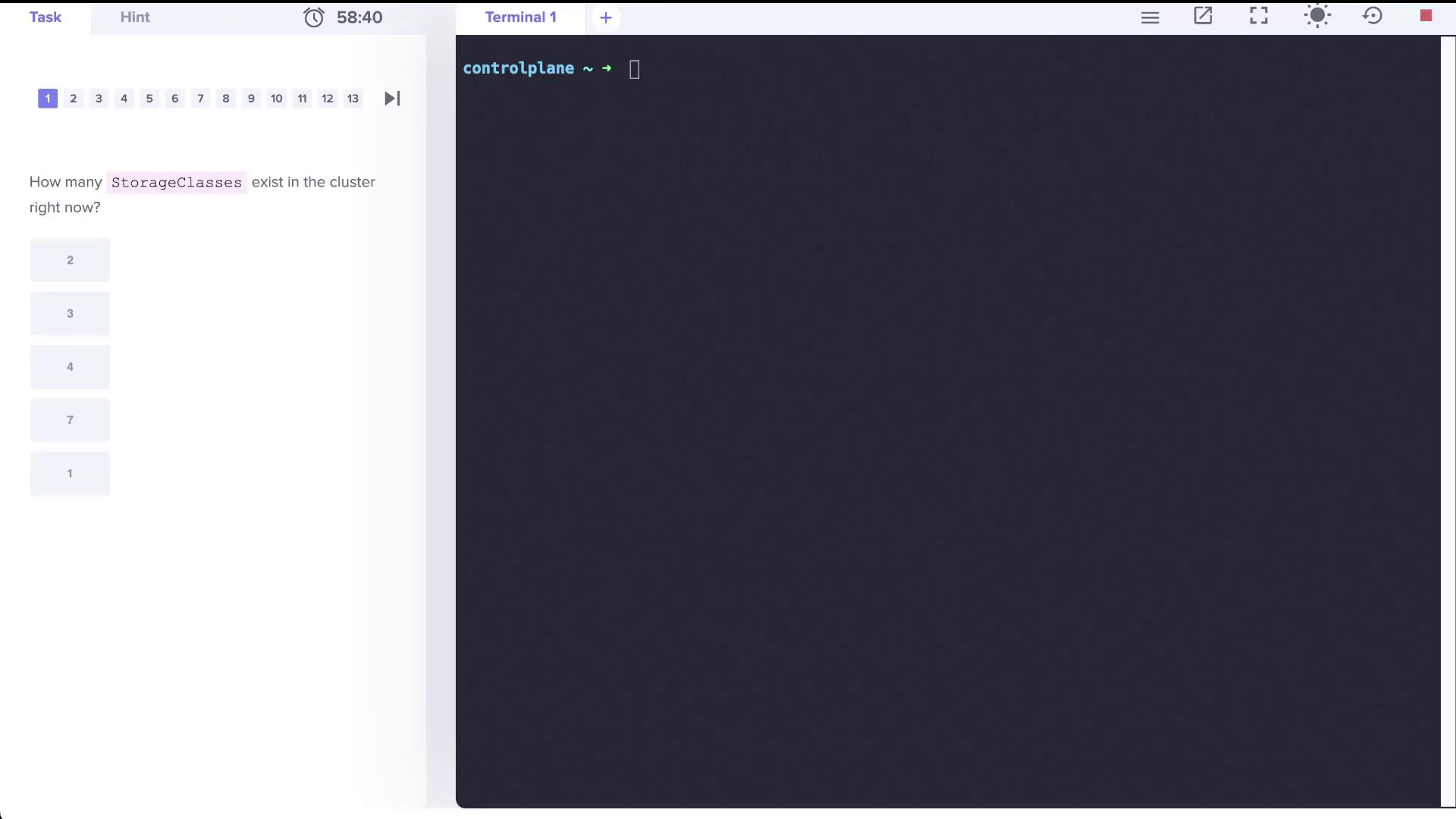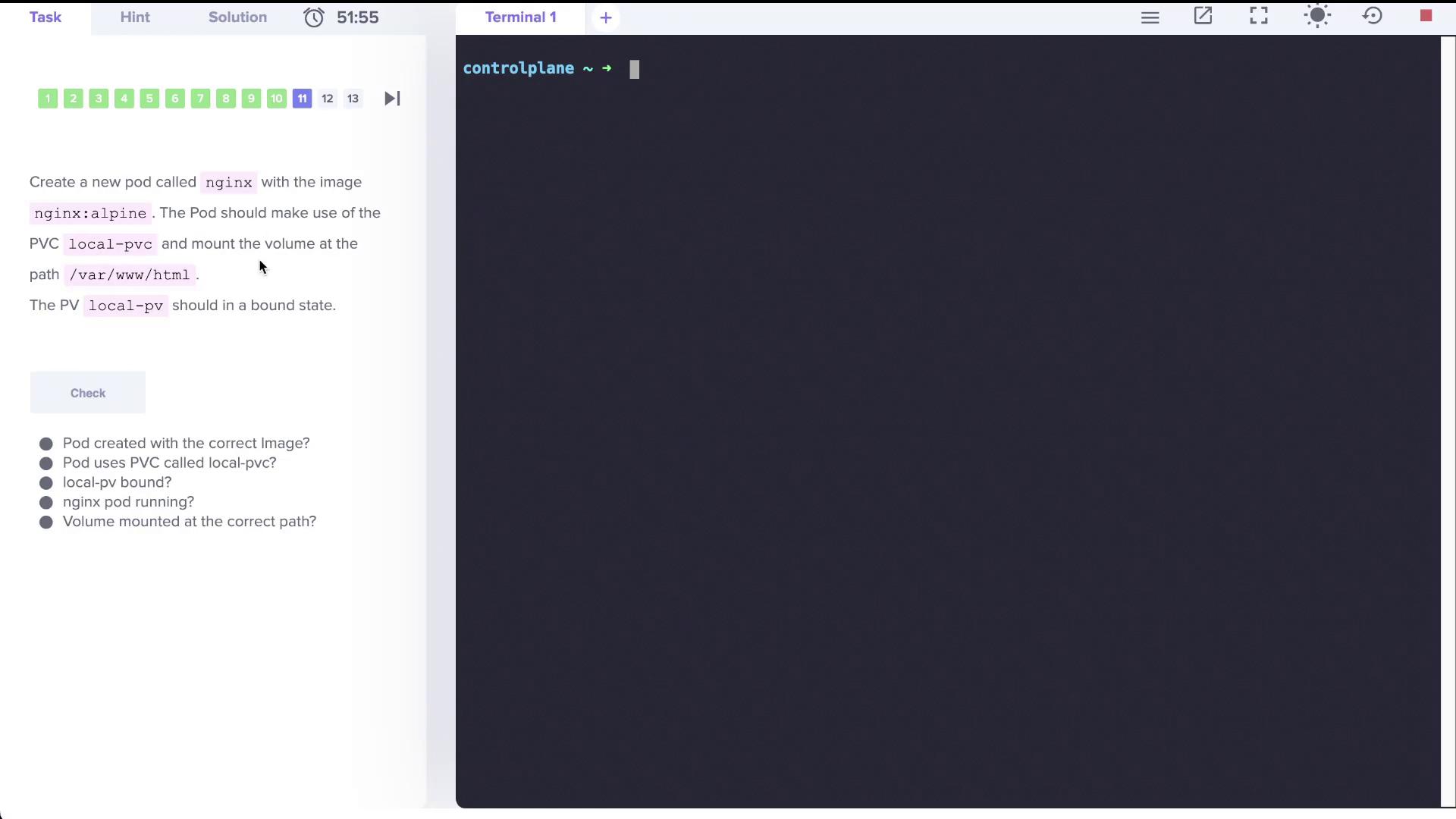CKA Certification Course - Certified Kubernetes Administrator
Storage
Solution Storage Class
In this lesson, we will explore storage classes in Kubernetes by reviewing their behavior and running hands-on labs. You will learn how to list storage classes, examine their properties, create persistent volume claims (PVCs), and deploy a pod to trigger volume binding. Finally, we will create a new storage class with on-demand binding.
Step 1: Checking Existing Storage Classes
Begin by determining how many storage classes exist in the cluster. Execute the following command:

kubectl get storageclass
The output should display a storage class similar to:
NAME PROVISIONER RECLAIMPOLICY VOLUMEBINDINGMODE ALLOW_VOLUME_EXPANSION AGE
local-path (default) rancher.io/local-path Delete WaitForFirstConsumer false 15m
You can also use the abbreviated command:
kubectl get sc
Both commands yield identical results.
Step 2: Reviewing Additional Storage Classes
Assume more storage classes have been created. Verify that there are now three storage classes:
kubectl get storageclass
or
kubectl get sc
An example output might be:
NAME PROVISIONER RECLAIMPOLICY VOLUMEBINDINGMODE ALLOW_VOLUME_EXPANSION AGE
local-path (default) rancher.io/local-path Delete WaitForFirstConsumer false 15m
local-storage kubernetes.io/no-provisioner Delete WaitForFirstConsumer false 6s
portworx-io-priority-high kubernetes.io/portworx-volume Delete Immediate false 6s
Key Observations
- local-storage uses the provisioner
kubernetes.io/no-provisioner, meaning it does not support dynamic volume provisioning. - The local-path storage class is set to bind volumes using the
WaitForFirstConsumermode. - portworx-io-priority-high employs the
kubernetes.io/portworx-volumeprovisioner.
Step 3: Working with Persistent Volumes (PVs) and Persistent Volume Claims (PVCs)
First, check if there is any PVC consuming a persistent volume (PV) named local-pv:
kubectl get pv
Example output:
NAME CAPACITY ACCESS MODES RECLAIM POLICY STATUS CLAIM STORAGECLASS REASON AGE
local-pv 500Mi RWO Retain Available local-storage local-storage - 110s
Next, verify that there are no PVCs created yet:
kubectl get pvc
Expected output:
No resources found in default namespace.
Since no PVC exists, create one that binds to the PV. The PVC must request 500Mi of storage, use the ReadWriteOnce access mode, and specify the local-storage storage class. Create a file named pvc.yaml with the following content:
apiVersion: v1
kind: PersistentVolumeClaim
metadata:
name: local-pvc
spec:
accessModes:
- ReadWriteOnce
resources:
requests:
storage: 500Mi
storageClassName: local-storage
After applying the YAML file, check the PVC status:
kubectl get pvc
Initially, the PVC may display a Pending status:
NAME STATUS VOLUME CAPACITY ACCESS MODES STORAGECLASS AGE
local-pvc Pending <none> <none> <none> local-storage 4s
For further details, inspect the PVC using:
kubectl describe pvc local-pvc
You might see an event similar to:
Events:
Type Reason Age From Message
---- ------ ---- ---- -------
Normal WaitForFirstConsumer 6s (x4 over 49s) persistentvolume-controller waiting for first consumer to be created before binding
This indicates that the WaitForFirstConsumer volume binding mode delays binding until a pod consumes the PVC.
Step 4: Deploying a Pod to Trigger PVC Binding
Deploy a pod named nginx that uses the PVC to initiate binding. This pod will run the nginx:alpine image and mount the PVC at /var/www/html. Refer to the image below for guidance:

Create a file named nginx.yaml with the following configuration:
apiVersion: v1
kind: Pod
metadata:
name: nginx
labels:
run: nginx
spec:
containers:
- name: nginx
image: nginx:alpine
volumeMounts:
- mountPath: /var/www/html
name: local-pvc-volume
volumes:
- name: local-pvc-volume
persistentVolumeClaim:
claimName: local-pvc
Deploy the pod with:
kubectl create -f nginx.yaml
After a short wait, recheck the PVC status:
kubectl get pvc
The output now should display that the PVC is Bound:
NAME STATUS VOLUME CAPACITY ACCESS MODES STORAGECLASS AGE
local-pvc Bound local-pv 500Mi RWO local-storage 4m47s
This confirms that creating the consumer pod triggered the binding of the PVC to the PV.
Step 5: Creating a New Storage Class with Delayed Binding
Finally, create a new storage class called delayed-volume-sc. This storage class utilizes a no-provisioner and employs the WaitForFirstConsumer volume binding mode. Prepare a file named delayed-volume-sc.yaml with the following content:
apiVersion: storage.k8s.io/v1
kind: StorageClass
metadata:
name: delayed-volume-sc
provisioner: kubernetes.io/no-provisioner
volumeBindingMode: WaitForFirstConsumer
Create the storage class by running:
kubectl create -f delayed-volume-sc.yaml
Verify by listing all storage classes:
kubectl get sc
Expected output:
| NAME | PROVISIONER | RECLAIMPOLICY | VOLUMEBINDINGMODE | ALLOW_VOLUME_EXPANSION | AGE |
|---|---|---|---|---|---|
| local-path (default) | rancher.io/local-path | Delete | WaitForFirstConsumer | false | 26m |
| local-storage | kubernetes.io/no-provisioner | Delete | WaitForFirstConsumer | false | 10m |
| portworx-io-priority-high | kubernetes.io/portworx-volume | Delete | Immediate | false | 10m |
| delayed-volume-sc | kubernetes.io/no-provisioner | Delete | WaitForFirstConsumer | false | 3s |
Lab Summary
In this lab, we covered the following topics:
- Listing and determining the number of storage classes in a Kubernetes cluster.
- Understanding the difference between dynamic and non-dynamic volume provisioning.
- Creating a PersistentVolumeClaim (PVC) and observing its binding behavior under the
WaitForFirstConsumermode. - Deploying a consumer pod (nginx) that triggers PVC binding.
- Creating a new storage class with delayed (on-demand) volume binding.
With these steps, you are now familiar with storage class configurations and the process of volume binding in Kubernetes. Enjoy managing your storage solutions efficiently!
For more details on Kubernetes storage, see Kubernetes Documentation.
Watch Video
Watch video content